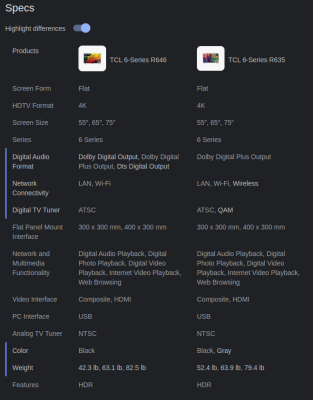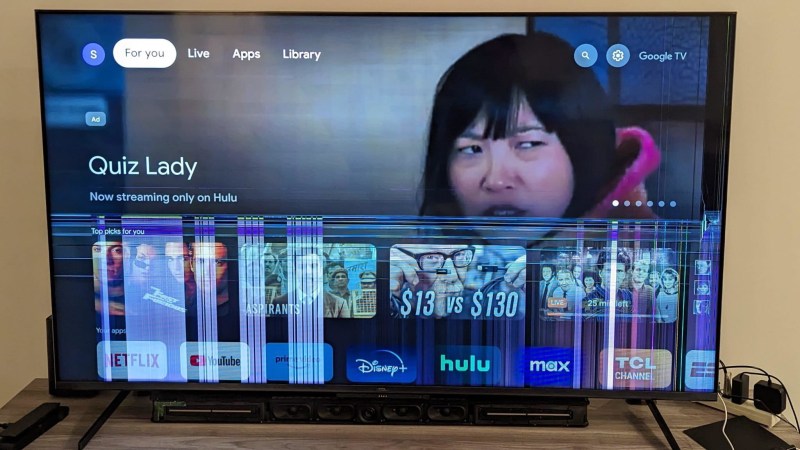[Sharad Shankar] repaired a broken TV by swapping out the cracked and malfunctioning image panel for a new one. Now, part-swapping is a great way to repair highly integrated modern electronics like televisions, but the real value here is something else. He documented his fix but the real useful part is his observations and guidance on how to effectively look for donor devices when the actual model of donor device can’t be found.
The usual approach to fixing a device by part swapping is to get one’s hands on two exact same models that are broken in different ways. But when it comes to consumer electronics with high turnovers — like televisions — it can be very difficult to actually locate any particular model once it’s no longer on shelves. [Sharad Shankar]’s broken TV was a 65″ TCL R646 purchased in 2021, and searching for a second 65″ TCL R646 was frankly like looking for a needle in a haystack. That’s when he got a visit from the good ideas fairy.
The first insight he had was that he didn’t actually need the exact same model of TV as a donor, he just needed the same display panel. The second insight was that TV manufacturers are absolutely using the same panels across different models of device. So he expanded his search to include similar TV models by the same manufacturer, hoping they contained the same display as the one he needed to replace.

This is more difficult than it may sound, because service manuals or similar low-level information about components in particular models of TV are not easy to find. In the end, [Sharad Shankar] did the following:
- Collect all the specs for his (cracked screen) TV.
- Find similar models made by the same manufacturer, preferably within a year or so.
- Compare the specs and make a short list of models that have the same screen size, screen technology, and display features as the original. (Features unrelated to the display can change.)
- Expand the search for a donor device to include these other potentials.
As luck would have it, he was able to locate a potential donor device on eBay thanks to his expanded search list. 75$ later, [Sharad Shankar] had the donor home and opened up to reveal some encouraging similarities between it and the broken original. A little part-swapping later, he once again had a working TV!
This method did require a bit of finger-crossing since it was impossible to be entirely certain that the parts would be compatible, but as far as calculated risks and educated guesses go, it was a solid play.
Keeping in mind that technology is designed and created by other humans and that certain things therefore are more likely than others can provide key insights when doing repair work or reverse engineering. Angles are usually clean divisions of 90°, and if calipers say 3.99 inches then it was probably actually designed as and intended to be 4.00 inches. And, as [Sharad Shankar] observed, consumer electronics like televisions are not completely redesigned and remanufactured from scratch with every model and release. Keep it in mind the next time you’re having trouble tracking down a part.

















Another reason it’s often hard to find an exact model number match is because of Amazon’s policy that all sellers and suppliers, if they want their products to be prime eligible, no other online store may offer the item at a lower price (to ensure that Amazon’s fulfillment fees come out of the seller’s margin rather than being passed on to the customer).
As a result many companies produce a different model / SKU *just* to sell on Amazon so they can offer the same product (but with a different model number and SKU) directly for a lower price on sites with less egregious lock-in and overhead.
We see a similar thing with power tools and laptops, for example. Many retailers will compete with “find the exact item elsewhere and we’ll beat it by 10%” shtick, but good luck finding that exact model no. anywhere else.
Not just those but home appliances too!
Yep, my Samsung refrigerator turned out to have an item number that was exclusive to the big box home improvement store where I bought it. Same enough that I could figure out the “real” number, but different enough to disqualify it from “price matching” (I presume).
for people who are wondering why he didn’t just keep the second TV and ditched the 1st: the 2nd TV was also broken but had a working screen.
So switching to needle in the haystack broken hardware but good screen?
Sometimes the same TV set can use different models of screens. Once I had a set that needed a new logic board. I found the board on Ebay, but when attached, the image was upside down and the colors weren’t right. I found another board (they were cheap enough), and this time the image was fine. More than likely, I could have just swapped out (or reprogrammed) the small EEPROM that contained the configuration settings. But it illustrates the fact that not all sets have the same parts, even if the model matches.
I completely agree with your point of view, because I have also encountered the same problem, even with the same master version, it cannot be directly replaced and used.
Just turn the TV upside down and squint👍
That is worthwhile to point out, it could easily get to where you have to order multiple broken sets, and with dead cheap TVs these days, money saving this way might not work out all that well. Though, if you want a dumb TV that you don’t have futz with walling it off from your network or having bypass the smart features through deeply nested and hidden menus, the used market is the only cheap option, and with a bit of luck you could end up just paying that $75 and have a working dumb TV.
Most TVs have a factory/service mode that can be entered from the remote through a combination of button presses. You can find the “secret” combination in the service manual elektrotanya.com is a good place to find those.
In factory mode, you can setup the panel orientation, colors, but timings, etc.
I did this with LCD monitors about 10-15 years ago when they still cost real money (or maybe I was just more poorer than I am today lol). As another commenter said, most of these components are made by third parties, and screens, boards, cables can sometimes be cross pollinated between models and brands.
I have a literal pile (7=pile for sure if you ask my wife) of “white box” non-smart 50 inch TV’s from work that all failed within a few months of each other. The LED’s are driven in 3 groups: each group comprising 3 strips in series. Lose 1 LED in one group and the other two still light up. Lose one LED in multiple groups and all is darkness.
After scavenging parts from some to fix others (easy to justify after breaking the LCD trying to disassemble!) I found the same strips on AliExp… referencing some number on the strips that doesn’t really seem to be a part number. “We’ll-sell-anything-we-can-lay-hands-on” Chinese retailers may have what you need if you get creative about searching.
The TV’s I have seem to have some parts in common with Polaroid and other “ultra-high-quality” units, but I never could nail down a matching brand.
(Who needs that many TV’s? I’m sure I will…someday… as soon as I can figure out how to make that stupid virtual pinball software do what I want it to.)
> [parts] can sometimes be *cross pollinated* between models and brands.
You sir receive +1 Internetz for this free of charge chuckle delivery. :-)
Board swapping on hard drives as a way of revival.
I use a similar method for figuring out who is OEMing certain devices from which manufacturers and passing them off as their own whilst lying about being designed in house or their country of origin.
I have a couple of dead Super Nintendo pads. They weren’t designed with ESD protection, so it’s common for the chip to fry. It’s a Mitsumi V520B, and I’ve been unable to find it reliably, and the rare times I found it it was outrageously overpriced. So I’ve just given up.
Aren’t those controllers essentially just parallel-in serial-out shift registers (or is that only the NES ones)? With all of the cheap tiny microcontrollers these days, probably somebody could revive those. I revived some old Atari joystick compatible trackball controllers with a PIC microcontroller some years ago.
Yes. The part in an SNES controller is likely a rebadge of a jellybean part. You can (still) get custom part numbers stamped on simple logic chips if you buy them in sufficient quantities.
Yes, that’s what it is. He could use a 12 or 16-bit shift register chip (or daisy chain an 8-bit with a 4 or 8-bit) and remap the pins with a PCB adapter to SOP-20 (probably custom).
Some of the specs from a quick search.
Pins:
NC Up L R X A B Y NC Gnd,
Down Left Right Select Start White Yellow Orange Red Brown
Serial:
B, Y, SELECT, START, UP, DOWN, LEFT, RIGHT, A, X, L, R, NA, NA, NA, NA
So, doesn’t the FCC (or whatever) certification help in this regard?
(In Finding sister devices) Yes, I know that I’m writing on an international forum.
And is it worth it? Our 4K 50″ set costs as low as $200 in Walmart. Not the brightest kid on the class obviously but gets the job done. I hope it lasts us a long time because pollution of course but apart from that I don’t see any profit in trying to fix it unless you’re a hardcore fixer. Or they make them modular and with interchangeable parts à la PC instead of gluing parts all together.
Outside TV repair shops there is always a bunch of broken TVs waiting to be picked by the trash truck. They’re so worthless not even thieves are interested in them even if they’re out there for the taking.
More repairs mean less garbage.
What search terms would one find TVs with broken hardware but good screens?